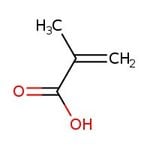Search Thermo Fisher Scientific
Methacrylic acid, 99%, stab. with 100-250ppm hydroquinone or 4-methoxyphenol, Thermo Scientific Chemicals



Methacrylic acid, 99%, stab. with 100-250ppm hydroquinone or 4-methoxyphenol, Thermo Scientific Chemicals
Chemical Identifiers
Specifications
Description
This Thermo Scientific Chemicals brand product was originally part of the Alfa Aesar product portfolio. Some documentation and label information may refer to the legacy brand. The original Alfa Aesar product / item code or SKU reference has not changed as a part of the brand transition to Thermo Scientific Chemicals.
Methacrylic acid is used as a monomer to prepare polymers. It acts a precursor for the preparation methyl methacrylate, N-substituted methacryl amides, methacrylamide, N-substituted methacryl amides and acryloyl chloride. It enhances the adhesion of surface coatings and adhesives. It acts as auxiliaries for the textile industry. It is involved in the preparation of poly(methacrylic acid)/montmorillonite nanocomposites, which finds application in the leather tanning process.
Solubility
Miscible with warm water, chloroform, ethanol, ether and organic solvents.
Notes
Incompatible with amines, strong bases, strong acids, oxidizing agents and peroxides.
Figures
Documents & Downloads
Certificates
Frequently asked questions (FAQs)
Citations & References
Safety and Handling
Classification of the substance or mixture
CLP classification - Regulation(EC) No 1272/2008
Label Elements
Signal Word
Danger
Hazard Statements
H302 + H332 - Harmful if swallowed or if inhaled
H311 - Toxic in contact with skin
H314 - Causes severe skin burns and eye damage
H335 - May cause respiratory irritation
EU Specific Hazard Statements
Combustible liquid
Precautionary Statements
P280 - Wear protective gloves/protective clothing/eye protection/face protection
P301 + P330 + P331 - IF SWALLOWED: Rinse mouth. Do NOT induce vomiting
P303 + P361 + P353 - IF ON SKIN (or hair): Take off immediately all contaminated clothing. Rinse skin with water or shower
P304 + P340 - IF INHALED: Remove person to fresh air and keep comfortable for breathing
P305 + P351 + P338 - IF IN EYES: Rinse cautiously with water for several minutes. Remove contact lenses, if present and easy to do. Continue rinsing
P310 - Immediately call a POISON CENTER or doctor/physician